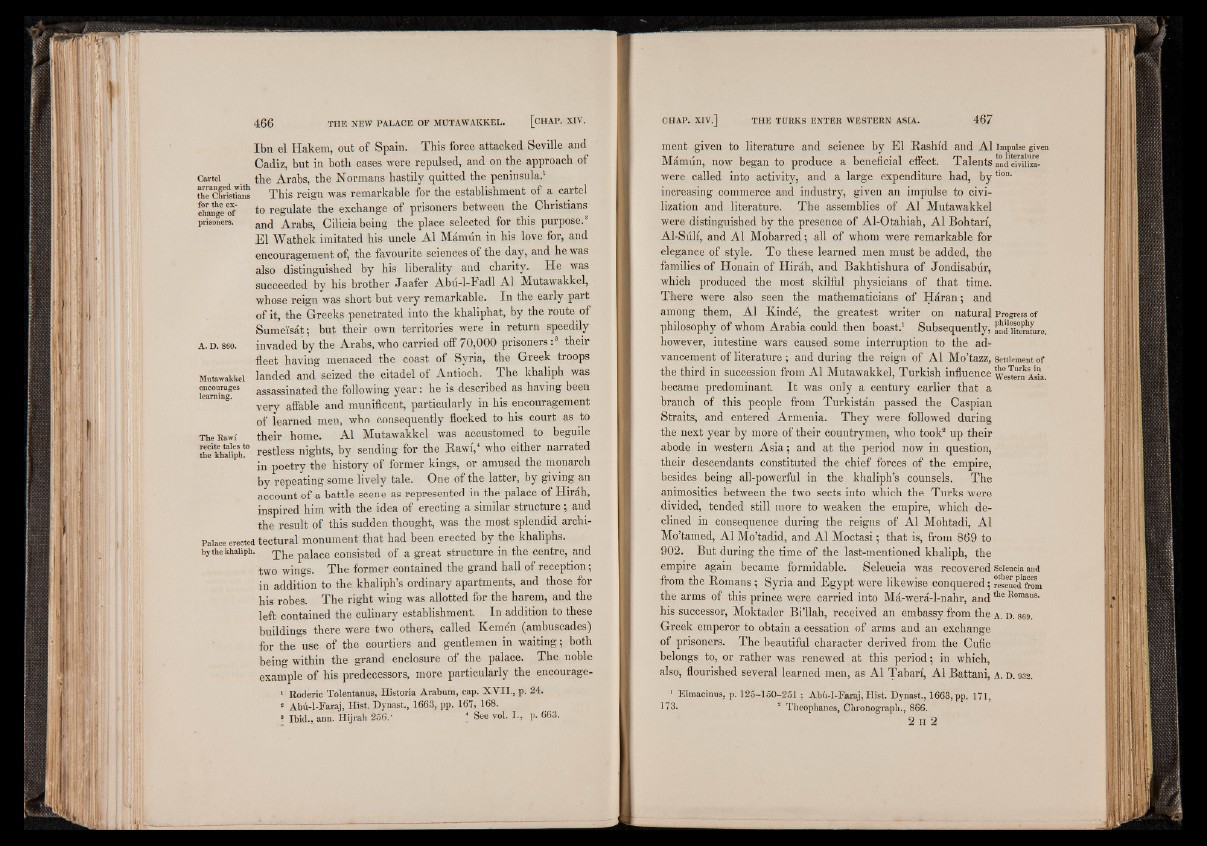
Ibn el Hakem, out of Spain. This force attacked Seville and
Cadiz, but in both cases were repulsed, and on the approach of
Cartel the Arabs, the Normans hastily quitted the peninsula.1
fbTchristTai« This reign was remarkable for the establishment of a cartel
change of" to regulate the exchange of prisoners between the Christians
prisoners. anq Arabs, Cilicia being the place selected for this purpose/
El Wathek imitated his uncle A1 Mamun in his love for, and
encouragement of, the favourite sciences of the day, and he was
also distinguished by his liberality and charity. He was
succeeded by his brother Jaafer Abu-1-Fadl A1 Mutawakkel,
whose reign was short but very remarkable. In the early part
of it, the Greeks penetrated into the khaliphat, by the route of
Sume'isat; but their own territories were in return speedily
A. d . 860. invaded by the Arabs, who carried off 7 0 , 0 0 0 prisoners :3 their
fleet having menaced the coast of Syria, the Greek troops
Mutawakkel landed and seized the citadel of Antioch. The khaliph was
ii™hTgeS assassinated the following year: he is described as having been
very affable and munificent, particularly in his encouragement
of learned men, who consequently flocked to his court as to
The Kawi their home. A1 Mutawakkel was accustomed to beguile
ihfkhinph!0 restless nights, by sending for the Rawi,4 who either narrated
in poetry the history of former kings, or amused the monarch
by repeating some lively tale. One of the latter, by giving an
account of a battle scene as represented in the palace of Hirah,
inspired him with the idea of erecting a similar structure , and
the result of this sudden thought, was the most splendid archi-
Paiace erected tectural monument that had been erected by the khaliphs.
by the khaliph. q^e pajace consisted of a great structure in the centre, and
two wings. The former contained the grand hall of reception;
in addition to the khaliph’s ordinary apartments, and those for
his robes. The right wing was allotted for the harem, and the
left contained the culinary establishment. In addition to these
buildings there were two others, called Kemen (ambuscades)
for the use of the courtiers and gentlemen in waiting; both
being within the grand enclosure of the palace. The noble
example of his predecessors, more particularly the encourage-
1 Roderic Tolentanus, Historia Arabum, cap. X V II., p. 24.
8 Abu-l-Faraj, Hist. Dynast., 1663, pp. 167, 168.
3 Ibid., ann. Hijrah 256.' 4 See vol. I ., p. 663.
ment given to literature and science by El Rashid and A1 impulse given
Mamun, now began to produce a beneficial effect. Talents IndSvu'iza-
were called into activity, and a large expenditure had, b y tlon-
increasing commerce and industry, given an impulse to civilization
and literature. The assemblies of A1 Mutawakkel
were distinguished by the presence of Al-Otahiah, A1 Bohtari,
Al-Suli, and A1 Mobarred; all of whom were remarkable for
elegance of style. To these learned men must be added, the
families of Honain of Hirah, and Bakhtishura of Jondisabur,
which produced the most skilful physicians of that time.
There were also seen the mathematicians of Haran; and
among them, A1 Kinde, the greatest writer on natural Progress of
philosophy of whom Arabia could then boast.1 Subsequently,
however, intestine wars caused some interruption to the advancement
of literature; and during the reign of A1 Mo’tazz, settlement of
the third in succession from A1 Mutawakkel, Turkish influence western Asia,
became predominant. It was only a century earlier that a
branch of this people from Turkistan passed the Caspian
Straits, and entered Armenia. They were followed during
the next year by more of their countrymen, who took2 up their
abode in western Asia; and at the period now in question,
their descendants constituted the chief forces of the empire,
besides being all-powerful in the khaliph’s counsels. The
animosities between the two sects into which the Turks were
divided, tended still more to weaken the empire, which declined
in consequence during the reigns of A1 Mohtadi, A1
Mo’tamed, A1 Mo’tadid, and A1 Moctasi; that is, from 869 to
902. But during the time of the last-mentioned khaliph, the
empire again became formidable. Seleucia was recovered Seieucia and
from the Romans ; Syria and Egypt were likewise conquered; rescued from
the arms of this prince were carried into Ma-wera-l-nahr, andthe Eomalls-
his successor, Moktader Bi’llah, received an embassy from the a . d . 869.
Greek emperor to obtain a cessation of arms and an exchange
of prisoners. The beautiful character derived from the Cufic
belongs to, or rather was renewed at this period; in which,
also, flourished several learned men, as A1 Tabari, A1 Battani, a . d . 932.
1 Elmacinus, p. 123-150-251 ; Abu-l-Faraj, H ist. Dynast., 1663, pp. 171,
173. 2 Theophanes, Chronograph., 866.
2 1 2